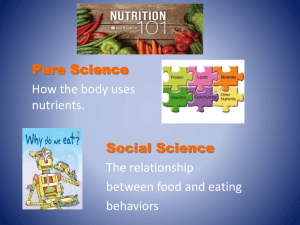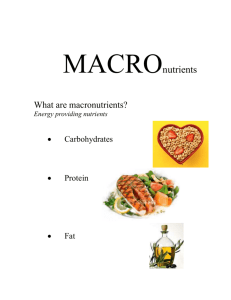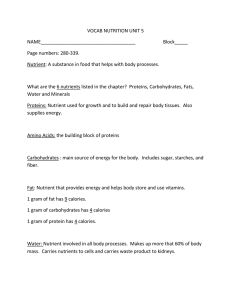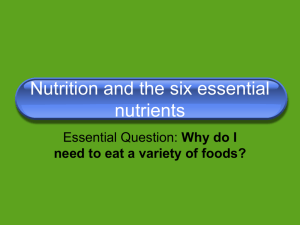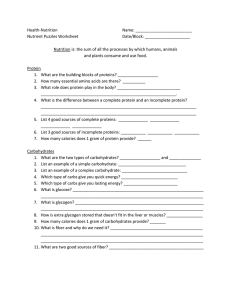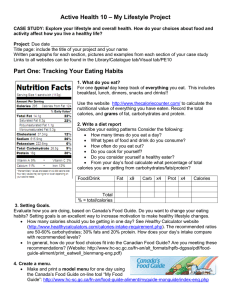Nutrition
advertisement
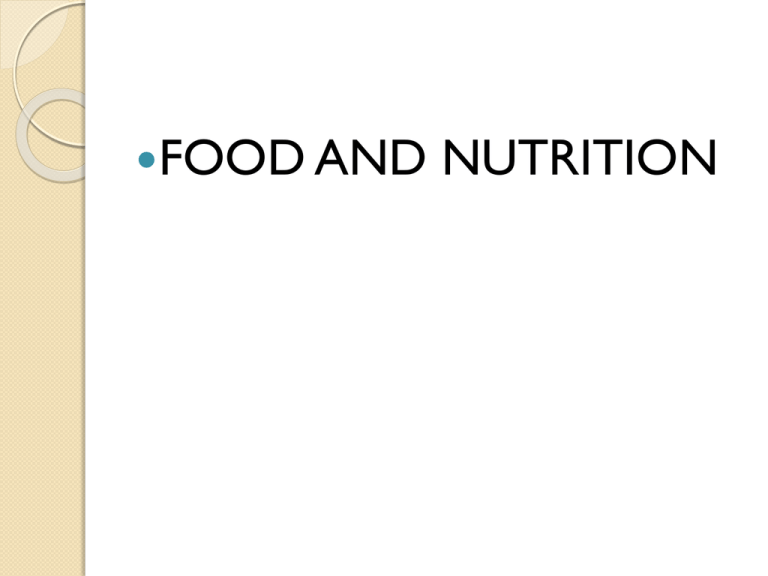
FOOD AND NUTRITION MY PLATE NUTRIENTS FOR PROPER NUTRITION A. GRAINS 1. Any food made from wheat, rice, oats, cornmeal, barley or another cereal grain is a grain product. a. Bread, pasta, oatmeal, breakfast cereals, tortillas, and grits are examples of grain products. 2. Whole grains are the type of grains you want to eat. A. Whole grains contain the entire grain kernel. 1. Examples: whole-wheat flour, oatmeal, brown rice. B. PROTEIN All foods made from meat, poultry, seafood, beans and peas, eggs, processed soy products, nuts, and seeds. C. VEGETABLES Any vegetable or 100% vegetable juice counts as a member of the Vegetable Group. 1. 5 SUB-GROUP OF VEGETABLES a. Dark Green 1. Broccoli b. Red and Orange 1. Carrots/Tomatoes c. 1. d. e. 1. Starchy Corn Beans and Peas Other Beets D. FRUITS Any fruit or 100% fruit juice counts as part of the Fruit Group. Fruits may be fresh, canned, frozen, or dried, and may be whole, cut-up, or pureed. E. DAIRY All fluid milk products and many foods made from milk are considered part of this food group. 1. Most Dairy Group choices should be fat-free or low-fat. 2. Foods made from milk that have little to no calcium, such as cream cheese, cream, and butter, are not. 3. Calcium-fortified soymilk (soy beverage) is also part of the Dairy Group B. % Daily Value – 20% is consider high (this is okay for fiber, vitamins, and minerals.) and 5% or lower isn’t very much (this is okay for fats, cholesterol, and sodium). C. Calorie – A unit of heat that measures the energy available in foods. 1. Too many will cause a gain in weight if not burned off. I. NUTRIENTS A. NUTRIENTS – SUBSTANCES IN FOODS THE BODY NEEDS IN ORDER TO GROW, HAVE ENERGY, AND STAY HEALTHY. Carbohydrates, Fats, & Proteins Something to think about! Poor eating habits and inactivity can harm young people now, & eventually your long term health! What does the saying “You are what you eat” mean to you? 6 Classes of Nutrients 1. 2. 3. 4. 5. 6. Carbohydrates Fats Proteins Vitamins Minerals Water Nutrient: Substance in food that provides energy & helps form body tissues & is necessary for life & growth Carbs, fats, & proteins are nutrients that provide energy! Important Definitions Metabolism: ◦ The sum of the chemical processes that takes place in your body to keep you alive & active Calories: ◦ The measurement of energy in food ◦ The # of calories depends on the amount of carbohydrates, fat, & protein it contains CARBOHYDRATES 1 GRAM = 4 CALORIES Your body’s main source of energy keeps your brain and muscles functioning! Carbohydrates are broken down into the bloodstream as GLUCOSE (blood sugar) 2 types of Carbs SIMPLE Quick energy Table sugar Candy Pop Fruit Milk COMPLEX Starches Must be broken down during digestion to provide body with energy Cereal Bread Rice and Pasta How much sugar should you have in a day? If you consume 2,000 calories a day No more than 10 teaspoons a day (40 g) 20 oz. Soda contains 16 teaspoons Diets high in added sugar have been linked to obesity, heart disease, osteoporosis Carbohydrates in your diet 45-65% of diet should be from carbohydrates 50% should be COMPLEX 10% should be SIMPLE TOO MUCH CARBOHYDRATES WILL TURN INTO FAT! FATS 1 GRAM = 9 CALORIES Promote healthy skin and normal cell growth Carry vitamins A, D, E, and K to wherever they are needed in the body 2 types of Fats Unsaturated Liquid or soft at room temperature Monounsaturated: Olive oil, avocados Lower risk of heart disease Polyunsaturated: Vegetable oils Omega-3: fish & seafood Extra protection against heart disease Transfat: veg oils formed into hard margarines Increase risk of heart disease Saturated Solid at room temperature Fatty meats Skin on poultry High-fat dairy products Obesity, +cholesterol, risk for heart disease Cholesterol A fatty substance found in animal & human tissues and blood Your body makes cholesterol Foods such as, meat, eggs, & dairy products 2 types of Cholesterol LDL HDL High Density Lipoprotein Carries back to liver where it is removed from blood High levels reduce risk for heart disease GOOD cholesterol Low Density Lipoprotein Brings to body cells Plaque forms when levels too high BAD cholesterol Fats in your diet Total fat intake for teens should be 25-35% of total caloric intake 10% should be SATURATED 20% should be UNSATURATED If you are eating a 2100 calorie diet no more than 700 calories (78 grams) should come from fat PROTEINS 1 GRAM = 4 CALORIES All parts of our body depend on protein for SURVIVAL Nutrients your body uses to build, repair, and maintain cells and tissues An energy source 2 types of Proteins Complete Animal foods Meat Fish Poultry Eggs, cheese, milk Soy & Tofu Incomplete Rice, wheat, corn Nuts Plant sources These do not contain all the essential amino acids your body needs Proteins in your diet 10-35% of diet should be from proteins MYTH: Eating extra protein is important if you want to build bigger muscles FACT: Muscles grow in response to strength training, not to an increase in protein intake If you eat too much protein, the extra amount will be stored as FAT! Chapter 7 Section 2 Page 161-166 Vitamins, Minerals, & Water Vitamins & Minerals Vitamins o Substances that help your body fight infections and use other nutrients among other jobs o Water soluble o B1, Folate, C o Fat soluble o A, D, E, K Minerals Elements that help form healthy bones and teeth, and regulate certain body processes o Nutrients naturally found in rocks & soil, not living things o Calcium, potassium, sodium, fluoride, zinc, chromium, & phosphorus Classes of Vitamins Fat-Soluble Dissolve in fat A, D, E, K Most are stored in fat tissue and remain for a long time Water-Soluble Dissolve in water Not stored in the body very well The eight B vitamins and vitamin C are water soluble Fat Soluble Vitamins o A Vision, immunity, skin & hair o D Bones & teeth; absorption of calcium & phosphorus in intestine o E Protects cell membranes from damage from free radicals o K Enables blood to clot Sources o A Carrots, spinach, yellow & orange fruits & veggies o D Milk, eggs, sunlight, tuna o E Whole-grain cereals, breads, beans o K Green, leafy veggies & cereals Water Soluble Vitamins Dissolve in water; bodies DO NOT store o C 60 mg/day Maintains immune system Formation of skin o B Produce energy from carbs; helps nervous system function properly o Folate Helps prevent birth defects; needed for forming cells Sources C Orange juice, tomatoes, citrus fruits One glass of OJ will give you your daily serving! o B Meat, poultry, & fish Grains o Folate Green veggies, beans, oj o Minerals o Calcium Bone & teeth, Muscle contraction, blood clotting Sources: milk & dairy o Potassium Regulation of fluid, maintains heartbeat & nerve impulses Sources: OJ, bananas, green, leafy veggies o Sodium Maintains water balance, muscles & nerve impulses Sources: salt o Fluoride strengthen tooth enamel, prevents cavities Sources: Fluoridated toothpaste and water Minerals o Chromium Regulates blood sugar Sources: Meat, herbs, dairy o Phosphorus Bone formation and cell reproduction Sources: Cereals, meat, poultry, milk o Zinc Growth & healing Production of digestive enzymes Sources: Seafood, meat, poultry, eggs, milk Nutrient Deficiency not having enough of a nutrient to maintain good health Sodium o o o Intake should be only 2,400mg/day About 1 ¼ tsp. Electrolytes: o Muscle movement, nerve signals, control fluid levels in body (Gatorade) Calcium o o o o Intake should be about 1,300 mg/day 8oz. of milk = 300 mg 45% of skeleton forms between 9 & 17 Osteoporosis: Disorder where the bones become brittle and break easily Water o 65% of your body weight o Carries waste out of body o Helps digest food o Helps raise body’s metabolism o Helps all chemical reactions o Temperature regulator o Try to drink as much as you can daily! IV. EATING DISORDERS Extreme eating behaviors that can lead to serious illness or even death. A. Anorexia Nervosa 1. An intense fear of weight gain, resulting in starvation b. Heart problems, kidney failure, death. Actress Mary-Kate Olsen is the poster child for the pro-anorexia online movement. Following a long period of denial, Mary-Kate eventually entered rehab, but has been unsuccessful at gaining and maintaining a significant amount of weight. B. Bulimia Nervosa An eating disorder in which a person repeatedly eats large amounts of food and then purges. a. Laxatives b. Vomiting C. Binge Eating Disorder A person eats large amounts of food at one time. Chapter 7 Section 3 pg. 167-174 Section 4 pg. 175-182 Meeting Your Nutritional Needs Recommended Dietary Allowance (RDA’s) Recommended nutrient intake that will meet the needs of most healthy people Guidelines, not exact requirements! Food Label Math You are to choose one of the following food labels and list the Calories: ◦ Calories from Fat ◦ Calories from Protein ◦ Calories from Carbohydrates Food Labels Serving size: 1. ◦ ◦ Shows the size for a single serving All values are in reference to this size Calories: 2. ◦ ◦ Total calories Calories from fat Ingredient List: 3. ◦ ◦ Listed on the label in order of weight Largest amount is listed first Food Labels How to calculate calories from grams? Fat: 1 gram = 9 calories Proteins: 1 gram = 4 calories Carbohydrates: 1 gram = 4 calories Other terms on food labels Calories: Calorie Free: less than 5 calories Light: 1/3 less calories Low Calorie: No more than 40 calories Reduced Calorie: 25% less calories Other terms on food labels Fat: Fat Free: less than 0.5 grams of fat Low Fat: 3 grams or less Extra Lean: less than 5 grams LOW FAT CAN STILL BE HIGH IN CALORIES! Athletes Diet HIGH in carbohydrates to provide the quick energy 2 hours before: eat a high-carb snack Examples: ½ bagel, handful of low-salt pretzels, or yogurt and fruit Fluid intake: ◦ ◦ ◦ ◦ 2 hours prior: 16 oz. Immediately before: 16 oz. Every 15 minutes during activity: 8 oz. After activity: 16-24 oz. For every pound of body weight lost Vegetarianism Semivegetarian: ◦ Not eat red meat ◦ Eats poultry and/or fish Lacto-ovo vegetarian: ◦ Not eat any meat ◦ Eats eggs and dairy products Vegans: ◦ Strictest type: do not eat any animal products
